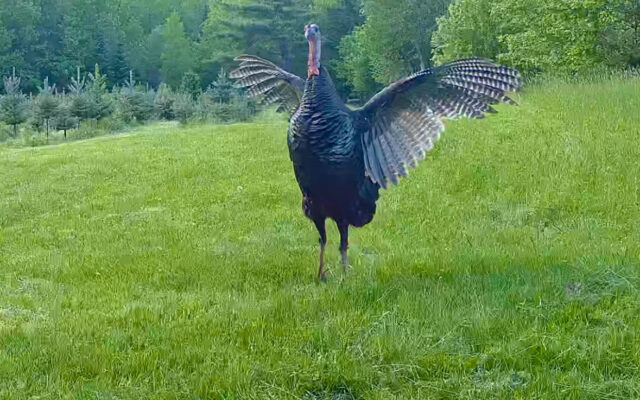
My spring turkey hunt didn’t go exactly as planned
By Pete Warner
It took a few extra minutes, but I rolled out of bed shortly after turning off my 4:15 a.m. alarm. It would be my last chance to go turkey hunting this spring and I was determined to find a gobbler.
It was nearly sunrise when I pulled into the field and parked. I figured the birds might be slow to fly down on a gray morning. The grass had grown so high that it might deter turkeys from walking through it.
I walked toward my blind, positioned at the convergence of some old skidder trails, but opted to head up onto an oak ridge. There would be decent visibility and an opportunity to call from a higher spot, potentially attracting some attention.
Picking my way quietly through the trees and blowdowns, I made some yelps and clucks with a diaphragm call. I stopped to remotely check my trail cameras and was surprised to find (without a notification) that a tom and a hen had moved past my blind at 4:48 a.m., about 10 minutes before my arrival.

That reinforced my thought about heading up the ridge, as the birds almost certainly had done likewise. I resumed my walk and heard a gobble in the distance.
It was maybe 200 yards away and I didn’t want to expose my position trying to improve my vantage point. Instead, I cozied up to a large rock that gave me a decent view in the direction from which they would approach.
I could see out to 40 yards in some spots and decided it would have to be good enough. I yelped periodically, which repeatedly elicited yelps and a gobble.
There were two turkeys, a hen and a gobbler, and they were headed my way. I cut way back on the calling and let them come, but they seemed to be moving deliberately.
The turkeys also were approaching from a low area behind a small rise, which prevented me from seeing them. The hen ramped up its raspy yelping and when it did, the gobbler blurted out a hearty gobble.
The problem was, they weren’t right together. The hen was directly in front of me, but remained on the far side of the rise at 60-ish yards. The gobbler was off to my right slightly and uphill.
My heart was pounding as I waited for them to emerge. I caught a glimpse of the hen as it made its way toward lower ground. Fearing its pursuit might go unfulfilled, the gobbler was obliged to follow.
When I finally saw it, I was already aiming at an opening on the near side of the rise. I had been counting on the turkey closing the distance slightly.
With the hen on the move, the preoccupied gobbler appeared along the higher ground for only 10 or 15 seconds, still out of range, before disappearing off the back side. They moved away purposefully, without making another sound. I never saw or heard them again.
If I had taken the time to move 10 or 15 yards in that direction when I first heard them calling, I almost certainly would have wound up with a shot opportunity.
Having gotten busted trying to close the distance on some turkeys earlier in the season, I thought the better of it. As it turns out, the contour of the ridge would have prevented them from seeing me. I just didn’t know it.
A little later, I tried climbing to the top of the ridge and calling, but there was no response. I hiked down to try another spot 500 or 600 yards away.
The sound of the water running through the outlet from the wetland must have dulled my hearing, because I was surprised by the clucking of three agitated turkeys in a nearby field. I could barely see the tops of their heads bobbing above the tall grass.
I wasn’t sure if they had seen me, but they were clearly riled up about something. Out of range, I stood still long enough for them to move into the woods, then tried to flank them.
It was a short maneuver. The path I chose on became difficult to negotiate, so I moved up into the woods on the back side of the field.
That resulted in a beautiful encounter with two young bucks that were grazing in the grass. One spotted me, but couldn’t tell what I was, and continued feeding. The other was oblivious to my presence.
Why, I wondered, could such sightings not happen during deer season?
Eventually, they wandered off and I continued my jaunt. A few minutes later, I discovered that a nice tom had crossed in front of a different camera some 200 yards away. I never saw it.
As I made my way back toward the truck, I reflected on the morning. There had been excitement and beauty, just as on my other turkey hunting trips this spring.
Wild turkeys are often elusive and unpredictable. They can perceive movement at long distances, and the simple snap of a twig can send them scurrying away.
Gobblers don’t necessarily come running in just because you call. They may look stupid, but they were smarter than this hunter.
It was a fun and memorable last day. I saw seven turkeys, with definitive IDs of the hen, the tom and what looked like three jakes.
The turkeys got the best of me again. And in one final taunting gesture, a gobbler ran up to my trail camera, flapped its wings and disappeared out of sight.